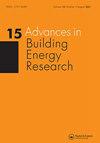Novel construction and demolition waste (CDW) treatment and uses to maximize reuse and recycling
IF 2.5
Q2 CONSTRUCTION & BUILDING TECHNOLOGY
引用次数: 25
Abstract
ABSTRACT The EU Waste Framework Directive 2008/98/EC states that all member states should take all necessary measures in order to achieve at least 70% re-use, recycling or other recovery of non-hazardous Construction and Demolition Waste (CDW) by 2020. In response, the Horizon 2020 RE4 project consortium (REuse and REcycling of CDW materials and structures in energy efficient pREfabricated elements for building REfurbishment and construction) consisting of 12 research and industrial partners across Europe, plus a research partner from Taiwan, was set up. For its success, the approach of the Project was manifold, developing sorting technologies to first improve the quality of CDW-derived aggregate. Simultaneously, CDW streams were assessed for quality and novel applications developed for aggregate, timber and plastic waste in a variety of products including structural and non-structural elements. With all products considered, innovative building concepts have been designed in a bid to improve future reuse and recycling of the products by promoting prefabricated construction methods and modular design to ease future recycling and increase value of the construction industry. The developed technologies and products have been put to the test in different test sites in building a two-storey house containing at least 65% of CDW.新型建筑和拆除废物(CDW)处理和使用,最大限度地重复使用和回收
摘要欧盟废物框架指令2008/98/EC规定,所有成员国应采取一切必要措施,在2020年前实现至少70%的无害建筑和拆除废物的再利用、回收或其他回收。作为回应,成立了Horizon 2020 RE4项目联合体(用于建筑改造和施工的节能pRE制造元件中CDW材料和结构的再利用和再循环),该联合体由欧洲的12个研究和工业合作伙伴以及台湾的一个研究合作伙伴组成。为了取得成功,该项目采用了多种方法,开发了分选技术,以首先提高CDW衍生骨料的质量。同时,对CDW流的质量进行了评估,并为各种产品(包括结构和非结构元件)中的骨料、木材和塑料垃圾开发了新的应用。考虑到所有产品,我们设计了创新的建筑概念,通过推广预制建筑方法和模块化设计来提高产品的未来再利用和回收利用率,从而简化未来的回收利用并增加建筑业的价值。开发的技术和产品已在不同的测试点进行了测试,以建造一栋含有至少65%CDW的两层房屋。
本文章由计算机程序翻译,如有差异,请以英文原文为准。
求助全文
约1分钟内获得全文
求助全文
来源期刊

Advances in Building Energy Research
CONSTRUCTION & BUILDING TECHNOLOGY-
CiteScore
4.80
自引率
5.00%
发文量
11
 求助内容:
求助内容: 应助结果提醒方式:
应助结果提醒方式:


